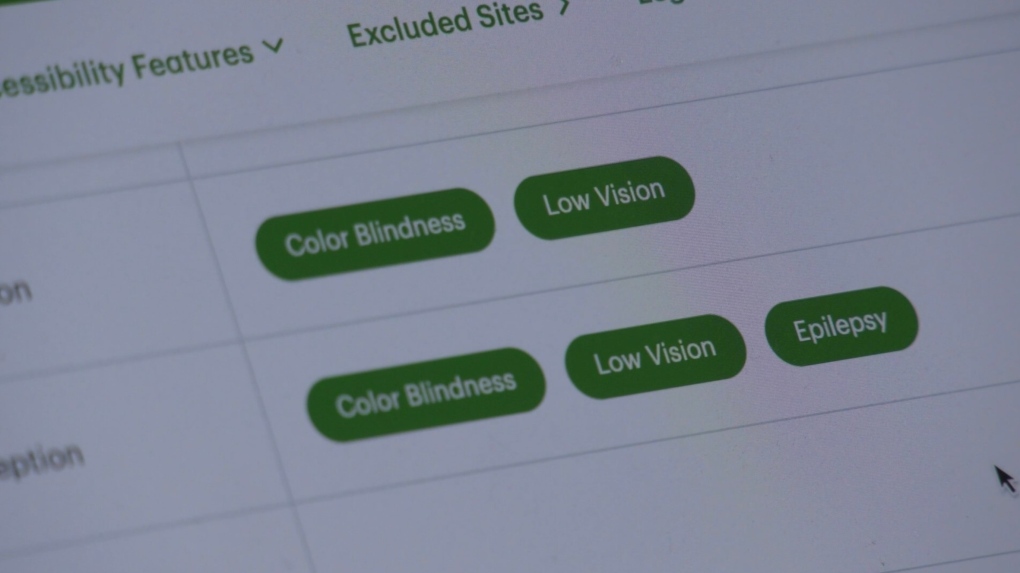New made-in-Kitchener technology makes internet more accessible for people with disabilities
A woman from Kitchener-Waterloo is leading the way when it comes to making the internet more accessible for people living with disabilities.
Samantha Estoesta is a project manager of social innovation specialization at TD, working out of Communitech in Kitchener.
Estoesta suffers from chronic migraines and describes them as debilitating. It's not uncommon for her to have to take medication just to make it through the workday.
"There's some days where I would need a sick day because it was just too painful," Estoesta said.
She spends much of her time at work in front of a screen, and certain websites act as a significant barrier between her symptoms and some relief.
"Over 90 per cent of the internet is traditionally inaccessible," she said.
She wanted to change that.
"Is there something we can do so that you have a seamless experience that really allows you to customize your own digital preferences and accessibility needs?" Estoesta asked herself.
The answer is yes. Estoesta and her team originally created the TD Accessibility Adapter
for their colleagues with disabilities. But after seeing a widespread need, they've now made it available to anyone in Canada or the U.S. for free.
It allows users to personalize every webpage they visit and automatically make them accessible for disabilities like ADHD, dyslexia and epilepsy. Once the settings are saved, it works on any website as long as you're using the Chrome browser.
 It allows users to personalize every webpage they visit and automatically make them accessible for disabilities like ADHD, dyslexia and epilepsy. (CTV News/Spencer Turcotte)For example, an ADHD mode blacks out everything on the screen except the single sentence being read to help with concentration.
It allows users to personalize every webpage they visit and automatically make them accessible for disabilities like ADHD, dyslexia and epilepsy. (CTV News/Spencer Turcotte)For example, an ADHD mode blacks out everything on the screen except the single sentence being read to help with concentration.
The dyslexia mode replaces all the font online with one that spaces out every letter and makes them more identifiable.
Low-saturation colours can also be used as a way to eliminate seizure triggers.
Estoesta uses lower light settings on her screen to help significantly minimize the symptoms of her migraines.
"I haven't taken a sick day yet for headaches since I started using them in March," she said.
An added benefit of the web extension is it doesn't require manager's approval to install. It gives employees more power in deciding whether they wish to disclose their disability.
"We're trying to change the day one accommodations conversations," Estoesta said.
CTVNews.ca Top Stories

Trump picks Brooke Rollins to be agriculture secretary
U.S. President-elect Donald Trump has chosen Brooke Rollins, president of the America First Policy Institute, to be agriculture secretary.
Walking pneumonia is surging in Canada. Is this unusual?
CTVNews.ca spoke with various medical experts to find out the latest situation with the typically mild walking pneumonia in their area and whether parents should be worried.
Lotto Max jackpot climbs to $80M, tying record for largest prize
The Lotto Max jackpot has climbed to $80 million for just the second time in Canadian lottery history.
Retiring? Here's how to switch from saving for your golden years to spending
The last paycheque from a decades-long career arrives next Friday and the nest egg you built during those working years will now turn into a main source of income. It can be a jarring switch from saving for retirement to spending in retirement.
Joly, Blair condemn anti-NATO protest in Montreal that saw fires, smashed windows
Federal cabinet ministers condemned an anti-NATO protest in Montreal that turned violent on Friday, saying 'hatred and antisemitism' were on display, but protesters deny the claim, saying they demonstrated against the 'complicity' of NATO member countries in a war that has killed thousands of Palestinians.
Police thought this gnome looked out of place. Then they tested it for drugs
During a recent narcotics investigation, Dutch police said they found a garden gnome made of approximately two kilograms of MDMA.
'Her shoe got sucked into the escalator': Toronto family warns of potential risk of wearing Crocs
A Toronto family is speaking out after their 10-year-old daughter's Crocs got stuck in an escalator, ripping the entire toe area of the clog off.
Canada's top general takes on U.S. senator in defending womens' role in combat units
Canada's top general firmly rejected the notion of dropping women from combat roles -- a position promoted by president-elect Donald Trump's nominee for defence secretary -- at a security forum underway in Halifax on Saturday.
Ottawa driver fined for hauling thousands of empty cans in trunk of car
Ontario Provincial Police stopped an Ottawa man for dangerously hauling thousands of empty cans from the back of his car.

































